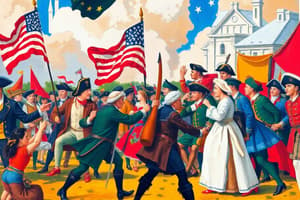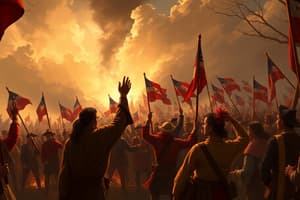Podcast
Questions and Answers
What significant event involved disguised Americans dumping tea into the harbor?
What significant event involved disguised Americans dumping tea into the harbor?
- Common Sense publication
- Battle of Bunker Hill
- First Continental Congress
- Boston Tea Party (correct)
The Quartering Act required British soldiers to provide shelter for American colonists.
The Quartering Act required British soldiers to provide shelter for American colonists.
False (B)
Name one of the ideological influences that contributed to the American Revolution.
Name one of the ideological influences that contributed to the American Revolution.
The Enlightenment or The Great Awakening
The __________ Act lowered the cost of tea for the East India Company.
The __________ Act lowered the cost of tea for the East India Company.
What was the main purpose of the Proclamation of 1763?
What was the main purpose of the Proclamation of 1763?
The Townshend Duties included taxes on printed materials.
The Townshend Duties included taxes on printed materials.
What rebellion was led by Ottawa leader Pontiac in 1763?
What rebellion was led by Ottawa leader Pontiac in 1763?
The group known for leading economic protests such as boycotts and the destruction of effigies was called the __________.
The group known for leading economic protests such as boycotts and the destruction of effigies was called the __________.
Match the following acts with their descriptions:
Match the following acts with their descriptions:
What event took place on March 5, 1770, in Boston?
What event took place on March 5, 1770, in Boston?
The British Parliament passed the Declaratory Act to assert its authority over the colonies.
The British Parliament passed the Declaratory Act to assert its authority over the colonies.
What were the main reasons for British resentment leading to taxation in the colonies after the French and Indian War?
What were the main reasons for British resentment leading to taxation in the colonies after the French and Indian War?
Which leader was associated with the Federalist movement?
Which leader was associated with the Federalist movement?
Antifederalists supported a strong central government.
Antifederalists supported a strong central government.
What were the Federalist Papers intended to accomplish?
What were the Federalist Papers intended to accomplish?
The Antifederalists published the __________ to warn about the dangers of a strong central government.
The Antifederalists published the __________ to warn about the dangers of a strong central government.
Match the following leaders with their corresponding movements:
Match the following leaders with their corresponding movements:
What did the Federalists hate about the political climate?
What did the Federalists hate about the political climate?
The Articles of Confederation effectively protected Americans and quelled rebellion.
The Articles of Confederation effectively protected Americans and quelled rebellion.
Who were considered the 'founding fathers' mentioned?
Who were considered the 'founding fathers' mentioned?
What document did Thomas Paine write that criticized monarchy?
What document did Thomas Paine write that criticized monarchy?
The Battle of Bunker Hill was a complete victory for the Continental Army.
The Battle of Bunker Hill was a complete victory for the Continental Army.
What was the significance of the Battle of Saratoga?
What was the significance of the Battle of Saratoga?
The ____ Congress adopted the Declaration of Independence on July 4th, 1776.
The ____ Congress adopted the Declaration of Independence on July 4th, 1776.
Match the following battles with their outcomes:
Match the following battles with their outcomes:
Which event marked the first armed conflict between British soldiers and American colonists?
Which event marked the first armed conflict between British soldiers and American colonists?
Washington's crossing of the Delaware was part of the strategy during the Battle of Trenton.
Washington's crossing of the Delaware was part of the strategy during the Battle of Trenton.
What problems did the Continental Army face during the winter at Valley Forge?
What problems did the Continental Army face during the winter at Valley Forge?
The Declaration of Independence included a list of _____ against the British Crown.
The Declaration of Independence included a list of _____ against the British Crown.
Who surrendered to Washington at Yorktown, effectively ending major combat in the war?
Who surrendered to Washington at Yorktown, effectively ending major combat in the war?
What was the significant ruling in the Dred Scott Decision?
What was the significant ruling in the Dred Scott Decision?
Stephen A. Douglas believed in the superiority of white people.
Stephen A. Douglas believed in the superiority of white people.
Who led the raid on Harpers Ferry?
Who led the raid on Harpers Ferry?
The average price of enslaved people was __________ during the rising tensions leading to the Civil War.
The average price of enslaved people was __________ during the rising tensions leading to the Civil War.
Match the following individuals with their political stance on slavery:
Match the following individuals with their political stance on slavery:
What did Chief Justice Roger B. Taney declare about Black people in the Dred Scott Decision?
What did Chief Justice Roger B. Taney declare about Black people in the Dred Scott Decision?
Lincoln believed in social and political equality of races.
Lincoln believed in social and political equality of races.
What was the main belief of Abraham Lincoln as a politician regarding slavery?
What was the main belief of Abraham Lincoln as a politician regarding slavery?
The __________ was a political compromise that was declared unconstitutional by the Dred Scott Decision.
The __________ was a political compromise that was declared unconstitutional by the Dred Scott Decision.
Match the events with their descriptions:
Match the events with their descriptions:
What was the slogan used by Polk during his presidential campaign?
What was the slogan used by Polk during his presidential campaign?
The Bear Flag Revolt established California as an independent republic.
The Bear Flag Revolt established California as an independent republic.
Who led the Texan forces during the Texas Revolution?
Who led the Texan forces during the Texas Revolution?
The Guadalupe - Hidalgo Treaty ended the Mexican American War in __________.
The Guadalupe - Hidalgo Treaty ended the Mexican American War in __________.
Which of the following was a result of the increased US territory after the Mexican American War?
Which of the following was a result of the increased US territory after the Mexican American War?
The Compromise of 1850 was primarily focused on expanding the Missouri Compromise.
The Compromise of 1850 was primarily focused on expanding the Missouri Compromise.
What was the main issue raised by the cession of territories acquired from Mexico?
What was the main issue raised by the cession of territories acquired from Mexico?
Flashcards
Committees of Correspondence
Committees of Correspondence
Organized committees of correspondence created by Samuel Adams in 1772 to coordinate resistance against British policies.
Tea Act of 1773
Tea Act of 1773
The 1773 Tea Act lowered the price of tea for the East India Company, making it cheaper than smuggled tea and creating resentment among colonists who saw it as an attempt to force them to buy from the company.
Boston Tea Party
Boston Tea Party
The Boston Tea Party, which occurred on December 16, 1773, was a protest by American colonists against the Tea Act, in which they dumped 342 chests of tea into Boston Harbor.
Intolerable Acts of 1774
Intolerable Acts of 1774
Signup and view all the flashcards
John Locke's Second Treatise of Government
John Locke's Second Treatise of Government
Signup and view all the flashcards
Salutary Neglect
Salutary Neglect
Signup and view all the flashcards
Pontiac's War
Pontiac's War
Signup and view all the flashcards
Proclamation of 1763
Proclamation of 1763
Signup and view all the flashcards
Taxation Without Representation
Taxation Without Representation
Signup and view all the flashcards
The Townshend Acts
The Townshend Acts
Signup and view all the flashcards
Sons of Liberty
Sons of Liberty
Signup and view all the flashcards
Boston Massacre
Boston Massacre
Signup and view all the flashcards
Road to Revolution
Road to Revolution
Signup and view all the flashcards
Manifest Destiny
Manifest Destiny
Signup and view all the flashcards
Mexican-American War
Mexican-American War
Signup and view all the flashcards
The Alamo
The Alamo
Signup and view all the flashcards
Treaty of Guadalupe Hidalgo
Treaty of Guadalupe Hidalgo
Signup and view all the flashcards
Mexican Cession
Mexican Cession
Signup and view all the flashcards
Wilmot Proviso
Wilmot Proviso
Signup and view all the flashcards
Compromise of 1850
Compromise of 1850
Signup and view all the flashcards
Fugitive Slave Act
Fugitive Slave Act
Signup and view all the flashcards
What was the Articles of Confederation?
What was the Articles of Confederation?
Signup and view all the flashcards
Who were the Federalists?
Who were the Federalists?
Signup and view all the flashcards
Who were the Antifederalists?
Who were the Antifederalists?
Signup and view all the flashcards
What were the Federalist Papers?
What were the Federalist Papers?
Signup and view all the flashcards
What were the Anti-Federalist Papers?
What were the Anti-Federalist Papers?
Signup and view all the flashcards
What was the process of ratifying the Constitution?
What was the process of ratifying the Constitution?
Signup and view all the flashcards
Who was Alexander Hamilton?
Who was Alexander Hamilton?
Signup and view all the flashcards
Who was James Madison?
Who was James Madison?
Signup and view all the flashcards
Revolutionary Ideologies
Revolutionary Ideologies
Signup and view all the flashcards
Thomas Paine
Thomas Paine
Signup and view all the flashcards
First Continental Congress
First Continental Congress
Signup and view all the flashcards
Battle of Bunker Hill
Battle of Bunker Hill
Signup and view all the flashcards
Lexington and Concord
Lexington and Concord
Signup and view all the flashcards
Second Continental Congress
Second Continental Congress
Signup and view all the flashcards
Declaration of Independence
Declaration of Independence
Signup and view all the flashcards
Battle of Trenton
Battle of Trenton
Signup and view all the flashcards
Battle of Saratoga
Battle of Saratoga
Signup and view all the flashcards
Winter at Valley Forge
Winter at Valley Forge
Signup and view all the flashcards
Dred Scott Decision
Dred Scott Decision
Signup and view all the flashcards
Kansas-Nebraska Act
Kansas-Nebraska Act
Signup and view all the flashcards
Caning of Charles Sumner
Caning of Charles Sumner
Signup and view all the flashcards
Raid on Harpers Ferry
Raid on Harpers Ferry
Signup and view all the flashcards
Lincoln-Douglas Debates
Lincoln-Douglas Debates
Signup and view all the flashcards
Election of 1860
Election of 1860
Signup and view all the flashcards
Abolition Movement
Abolition Movement
Signup and view all the flashcards
"On the Origin of Species"
"On the Origin of Species"
Signup and view all the flashcards
Increasing price of enslaved people
Increasing price of enslaved people
Signup and view all the flashcards
African Labor Supply Association
African Labor Supply Association
Signup and view all the flashcards
Study Notes
General Study Notes
- No specific text or questions provided. Please provide the relevant material for me to create study notes.
Studying That Suits You
Use AI to generate personalized quizzes and flashcards to suit your learning preferences.




